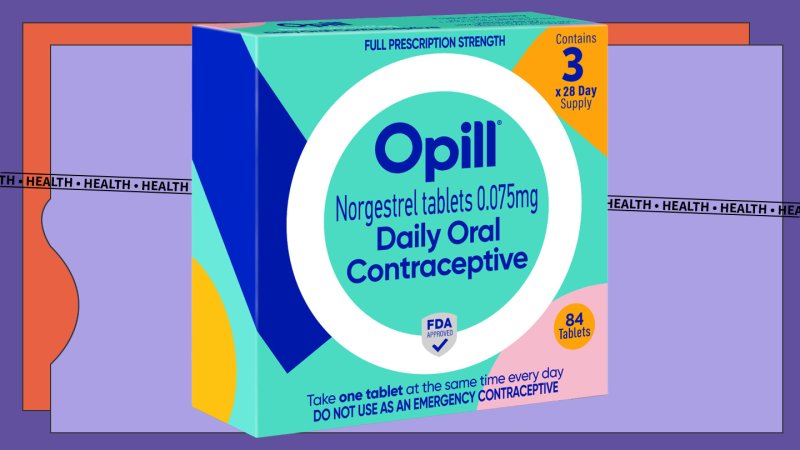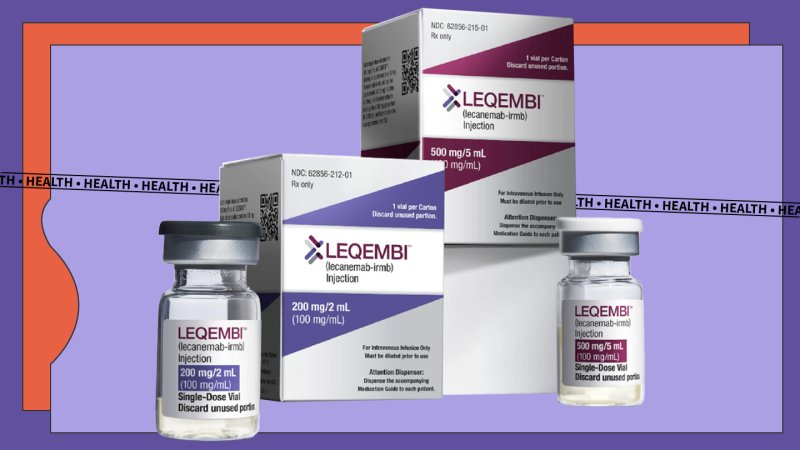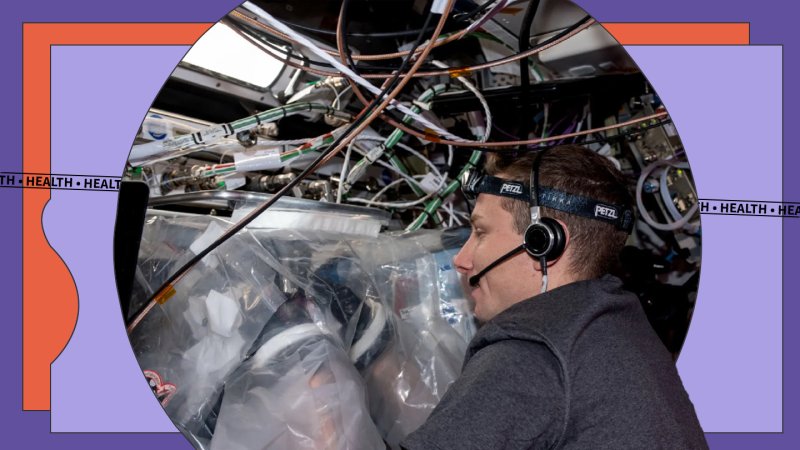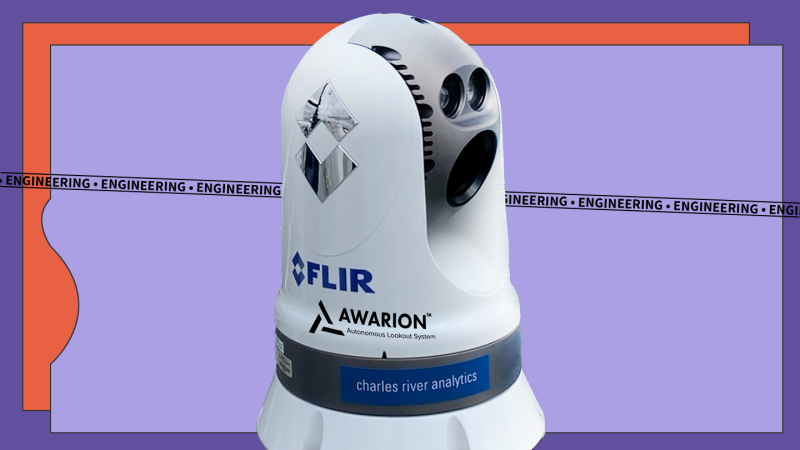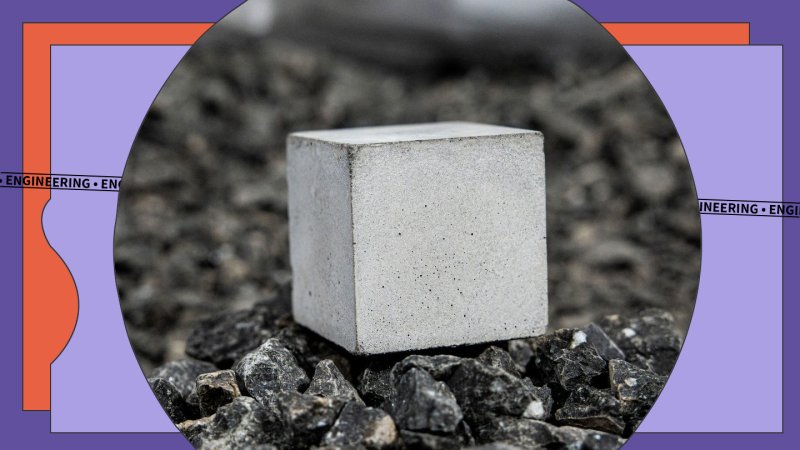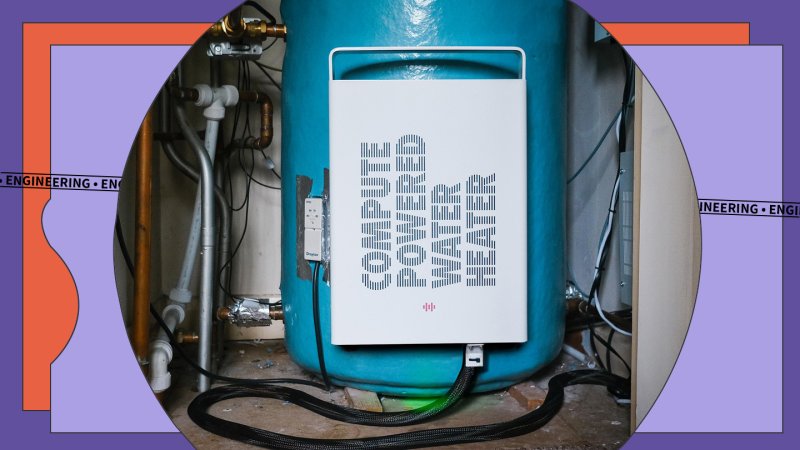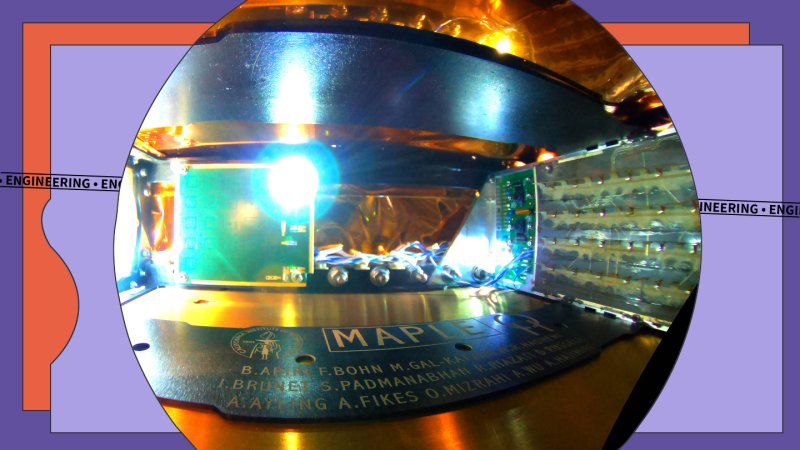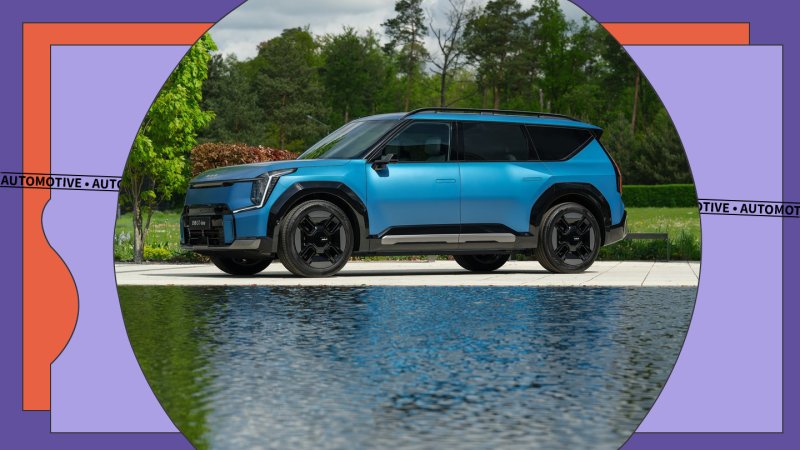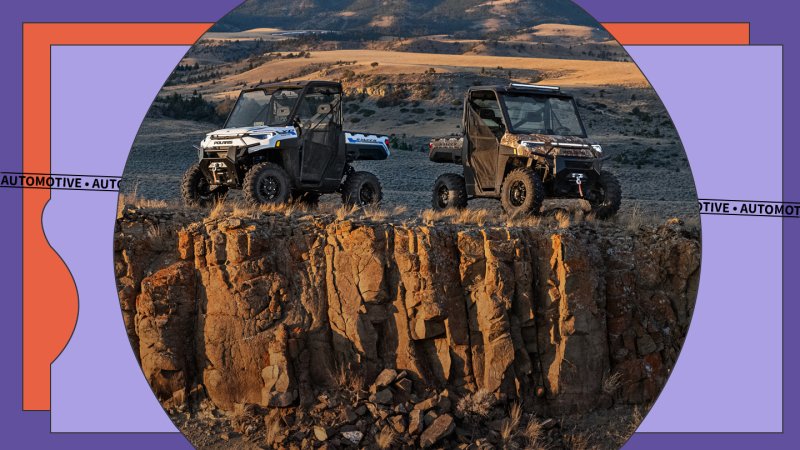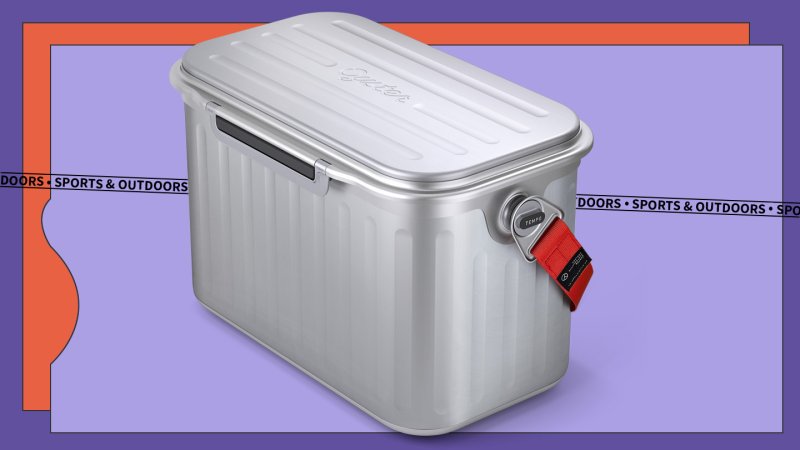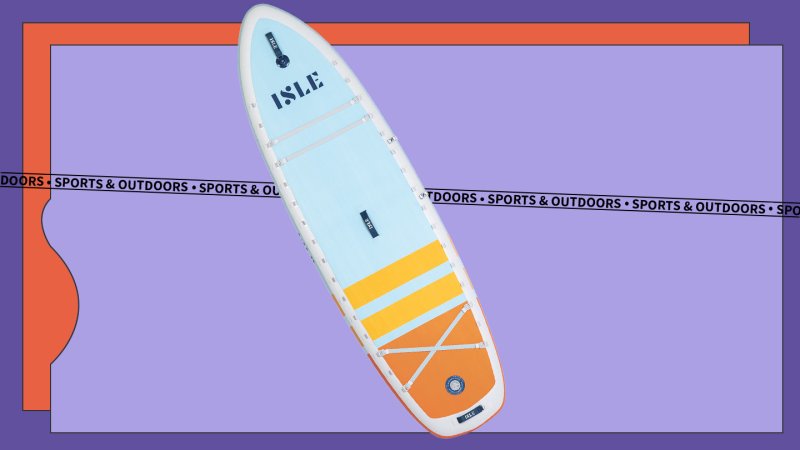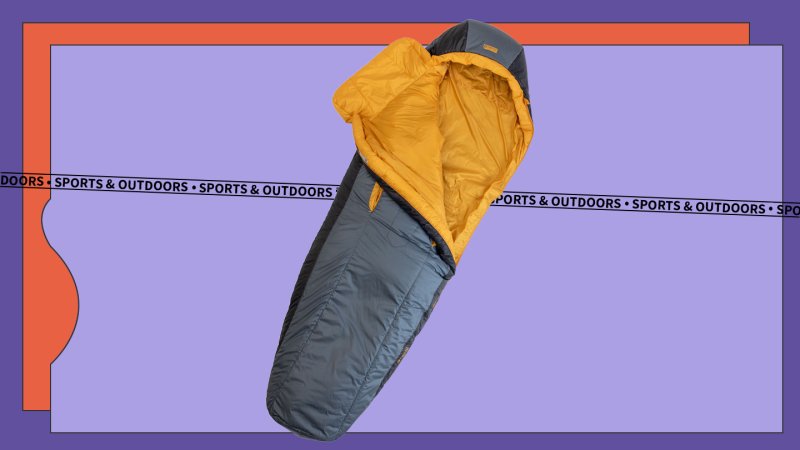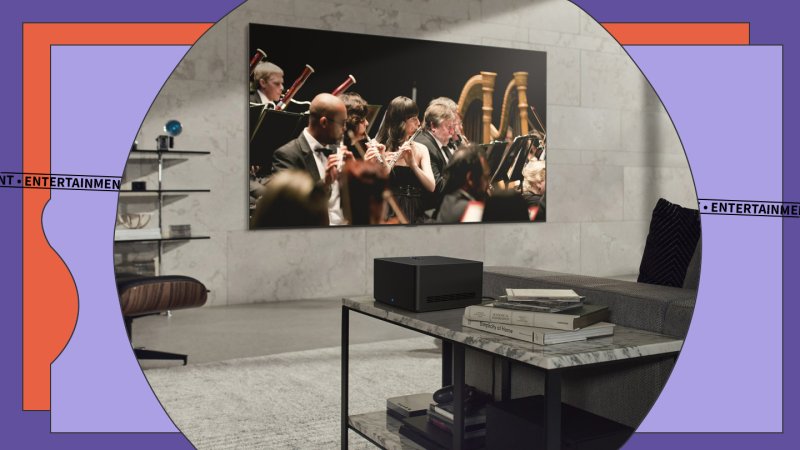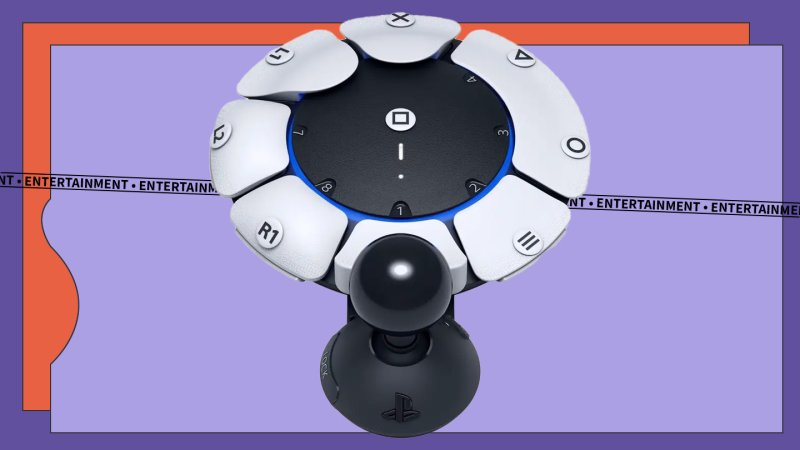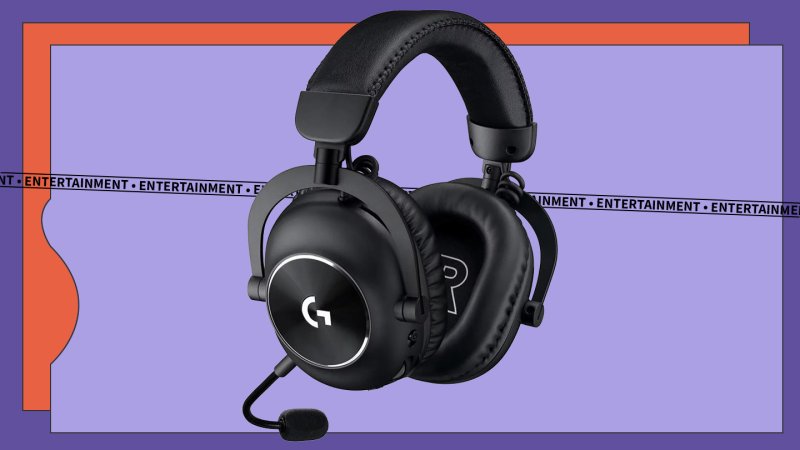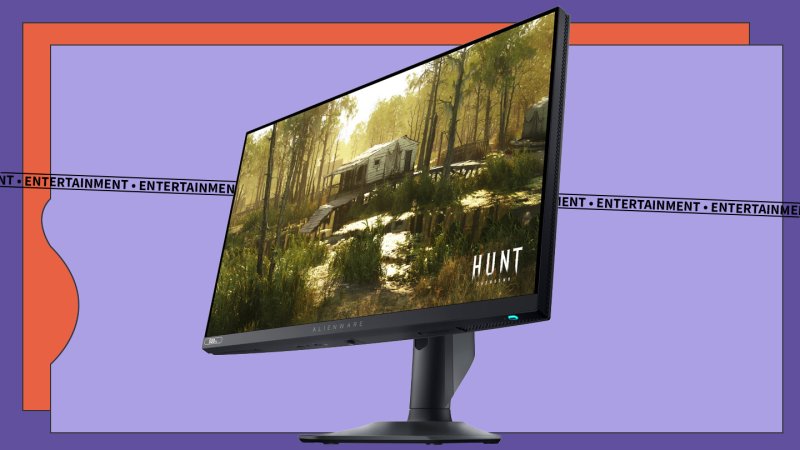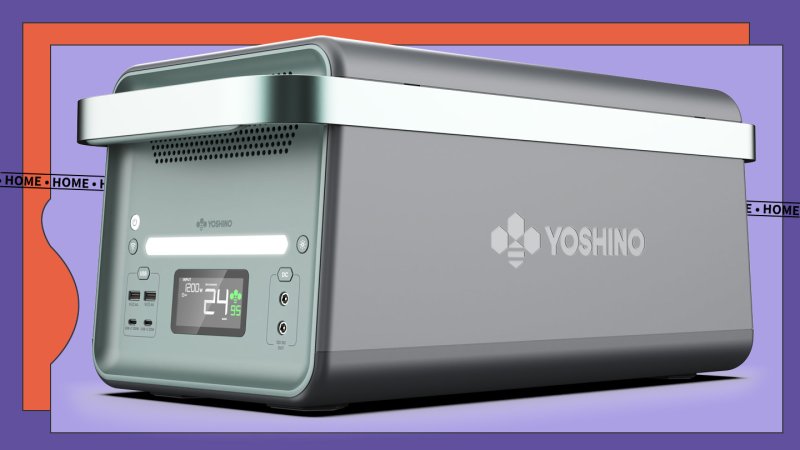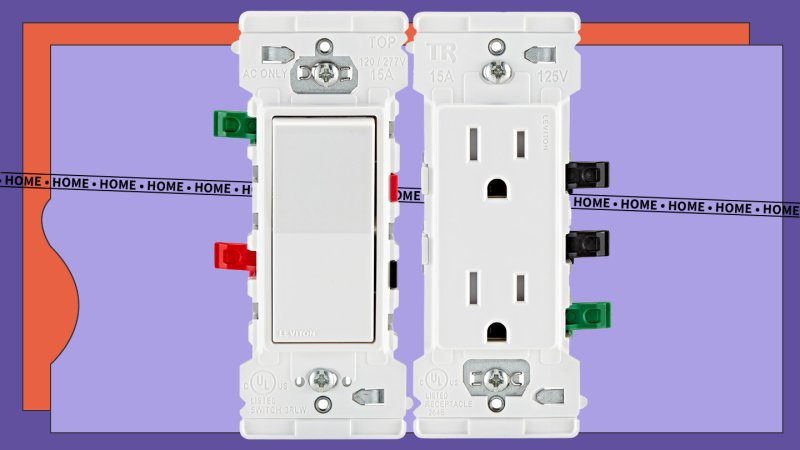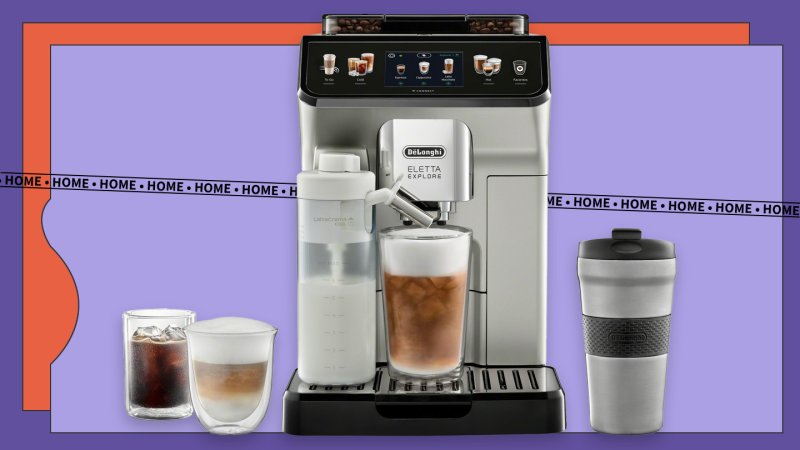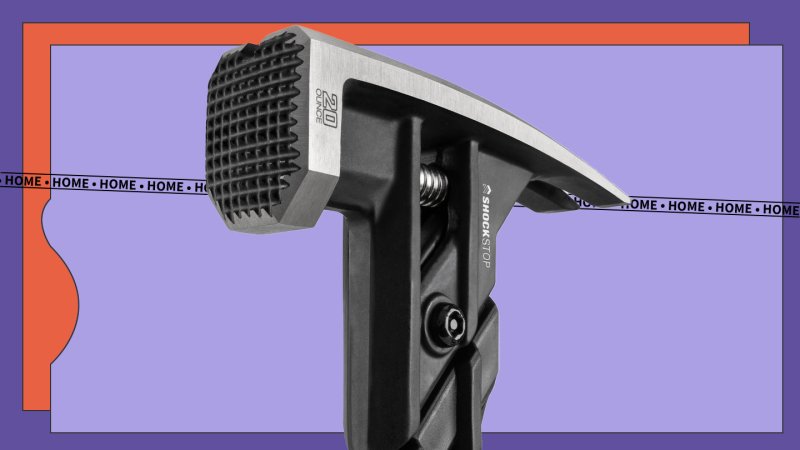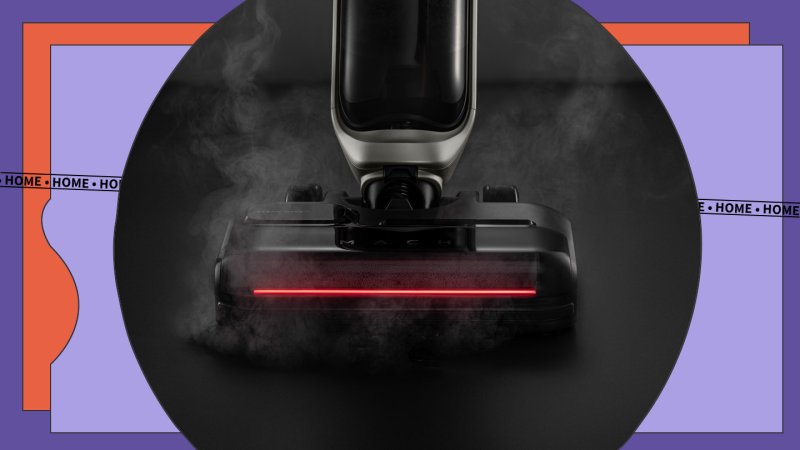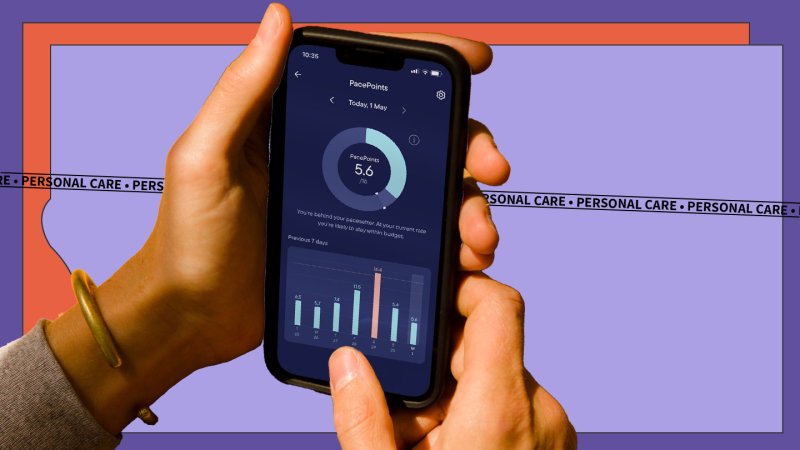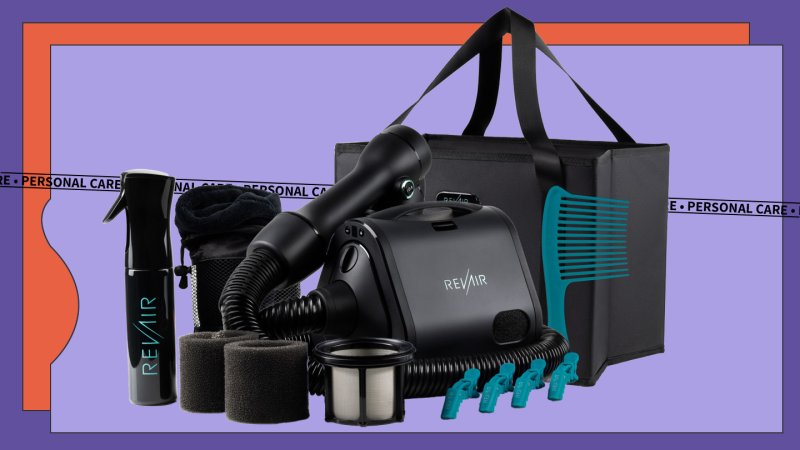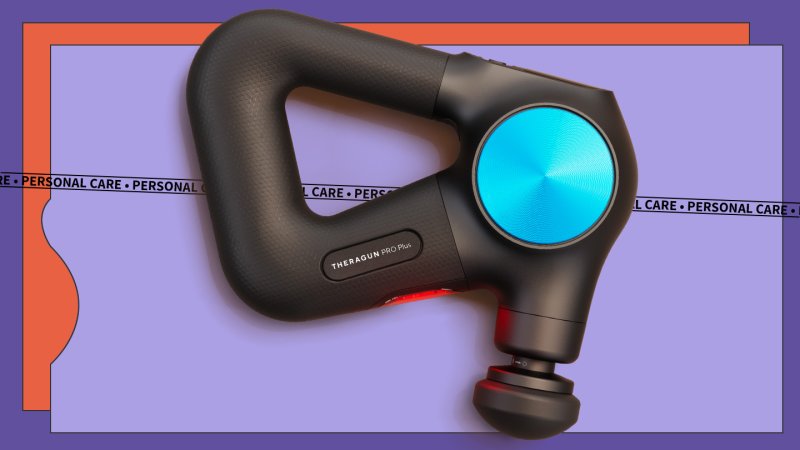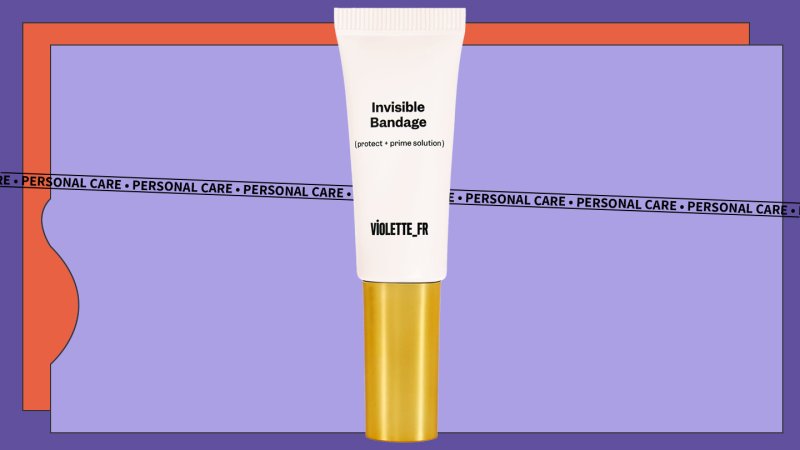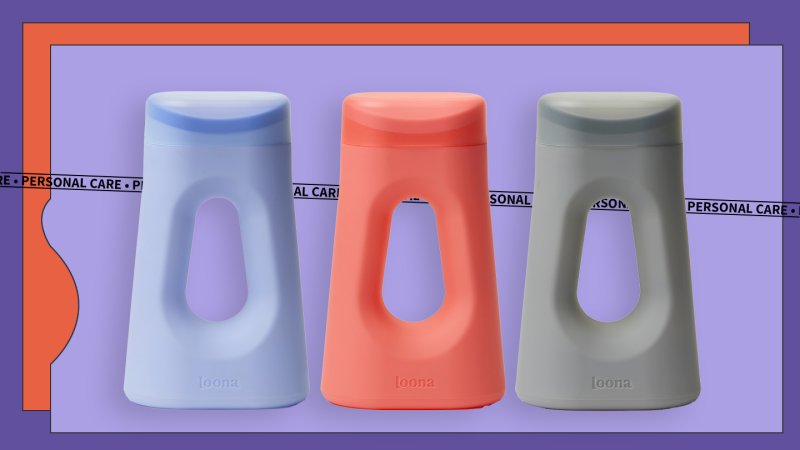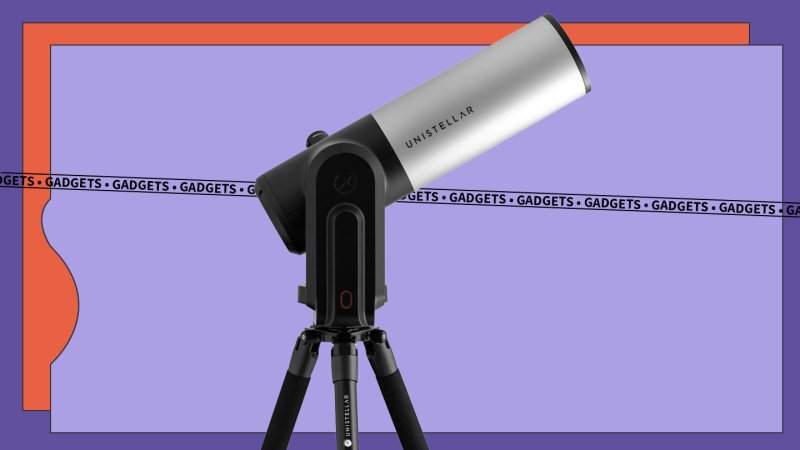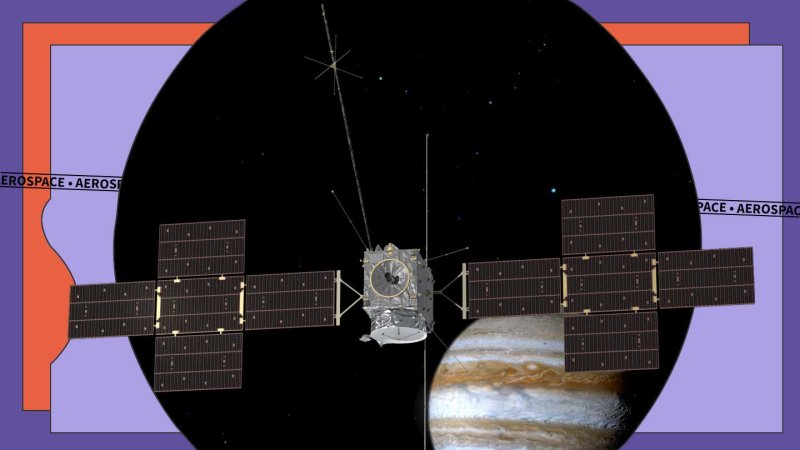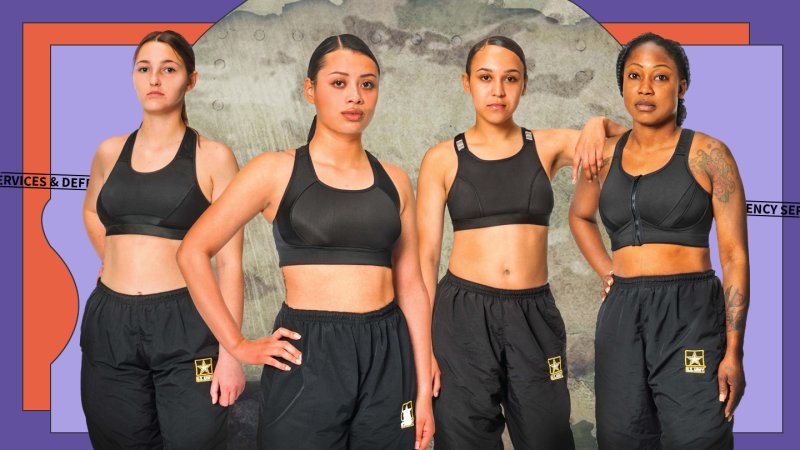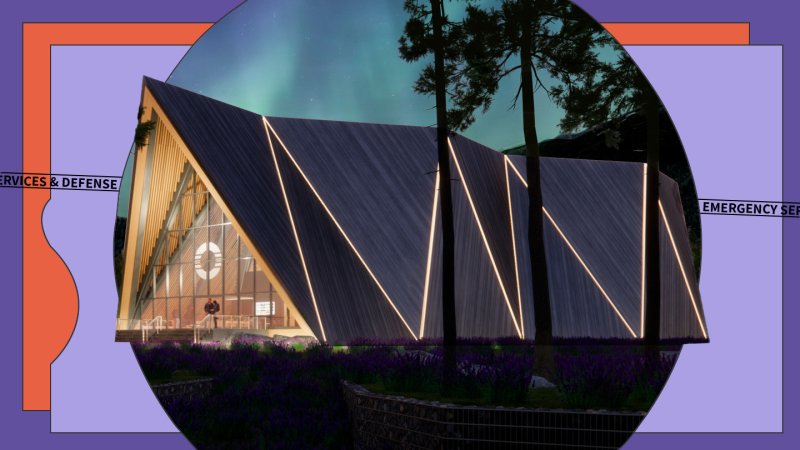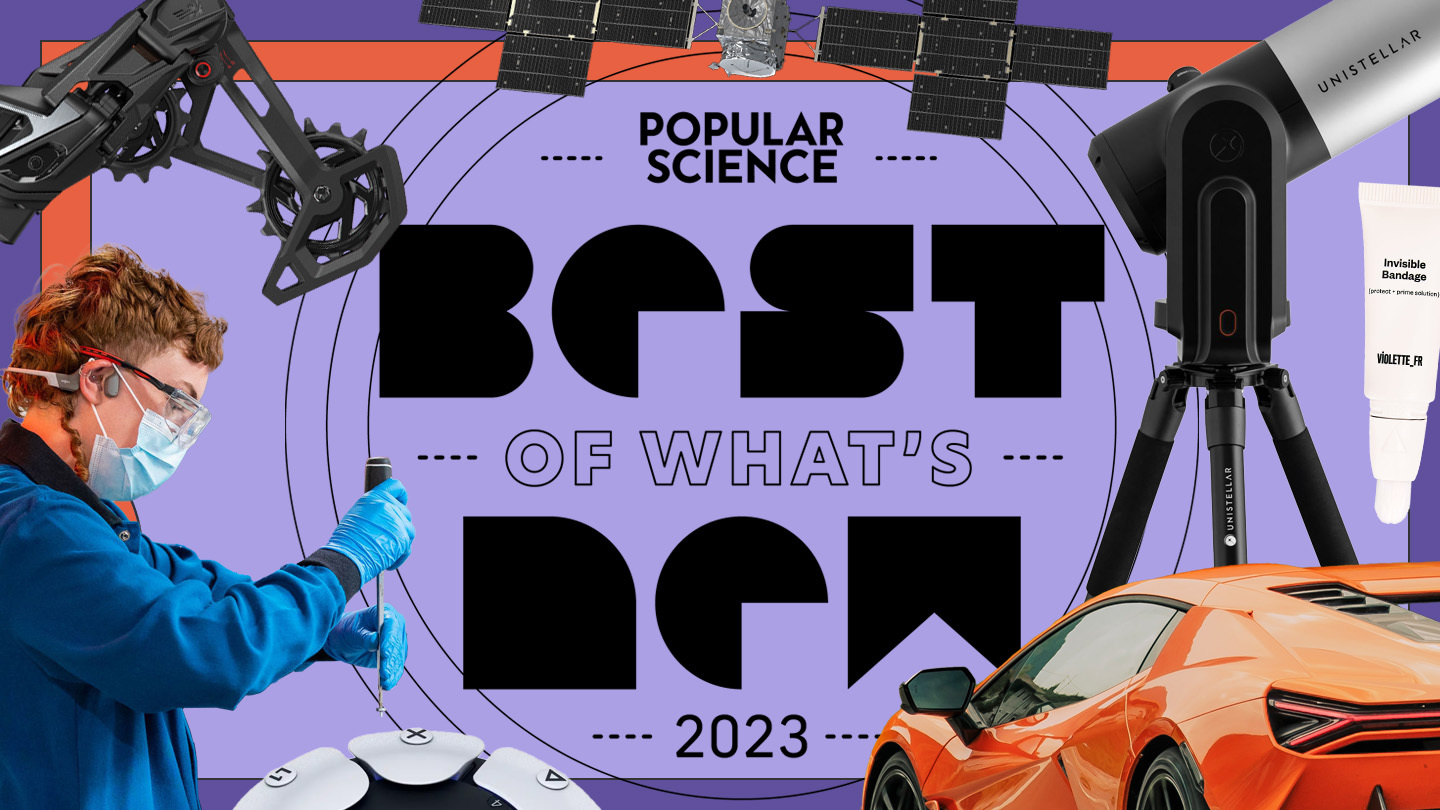

We may earn revenue from the products available on this page and participate in affiliate programs. Learn more ›
Here at Popular Science we celebrate innovation. Whether it’s a new medical treatment, infrastructure project, consumer product, or big idea, they almost always spring up as the solution to a problem. Some honorees address age-old annoyances while others speak to larger and even existential issues that profoundly affect people around the globe. This year, we’ve selected honorees that exemplify this desire to improve people’s lives, just as we have every year since 1988.
Here are the innovations that affected our world in 2023.
- Health
- Engineering
- Auto
- Sports & Outdoor
- Entertainment
- Home
- Personal Care
- Gadgets
- Aerospace
- Emergency Service and Defense
Health
It takes time for scientists and drug makers to move the needle in medicine. But during public health emergencies like the pandemic, they need to act urgently without compromising safety, quality, and effectiveness. Opill is a shining example of that. The US Food and Drug Administration approved the over-the-counter contraceptive in just 13 months (some approvals take longer than a decade). The open access will benefit millions of people, which is why PopSci chose it as the 2023 “Innovation of the Year.” Timeliness also factored into the FDA’s decisions to green-light extraordinary new treatments for RSV, Alzheimer’s, and muscular dystrophy this year. Finally, the budding field of space medicine took a big leap with a successful 3D printing experiment in microgravity.
Innovation of the Year
Opill by Perrigo: The first over-the-counter birth control pill in the US
When Roe v. Wade was overturned in 2022, Americans were stripped of a crucial female reproductive healthcare right. Nearly half of the 6.1 million pregnancies in the US are unplanned. But the release of an affordable birth control pill means that anyone can get contraceptives anywhere in the country. It’s the first over-the-counter option since the FDA approved birth control pills back in 1960.
Opill is a progestin-only tablet that’s up to 98 percent effective when taken at the same time every day. The generic version, norgestrel, was developed by Pfizer and prescribed for decades. Perrigo purchased the license in 2015, rebranded the drug, and applied for nonprescription status just days before the US Supreme Court ruled against abortion. The contraceptive has a few nominal side effects, including nausea, headaches, and cramps, but shouldn’t cause disruptions like mood swings and weight gain. Though Opill won’t be available in pharmacies and online retailers until early 2024, its arrival represents one solution for the country’s current reproductive health battles.
LEQEMBI by Eisai: A life-changing treatment for early Alzheimer’s disease
By 2060, the number of people around the world living with Alzheimer’s is expected to triple to 14 million. LEQEMBI, a newly approved antibody treatment, has been hailed “revolutionary” by neurologists because it is the only drug clinically shown to reduce the number of amyloid plaques that build up in the brain with the disease and slow down cognitive decline. It is only for patients with mild memory loss and other symptoms—about 15 to 20 percent of the affected population—and is delivered through an IV infusion every two weeks. LEQEMBI is expected to be covered by Medicare and reach at least 10,000 individuals by 2024.
Abrysvo by Pfizer: Building immunity in the womb
RSV is the leading cause of infant hospitalization in the US. While there is a vaccine available for babies and toddlers, it’s now possible to immunize them even earlier. Abrysvo is the first FDA-approved shot targeting the respiratory illness in individuals who are expecting. One dose, administered between 32 and 36 weeks of pregnancy, can deliver antibodies to the fetus through the placenta. A clinical trial involving nearly 3,700 vaccinated individuals and their infants found Abrysvo was 81.8 percent effective in preventing the virus up to 90 days after birth.
3D Biofabrication Facility (BFF) by Redwire: Printing knee replacements in microgravity
Your next knee replacement could be out of this world—literally. In January, NASA astronauts installed a bioprinter on the International Space Station that uses human tissue cells to replicate meniscuses, which are notoriously hard to repair. Meniscal tears are one of the most common knee injuries, affecting 12 to 14 percent of people and many US veterans. The microgravity in orbit helps the printed part hold its shape until the cells are fully cultured. The BFF produced its first test meniscus in September: The sample survived the journey back to Earth and is now being analyzed at a military medical school.
Elevidys by Sarepta Therapeutics: A profound way to treat muscular dystrophy
Duchenne muscular dystrophy is a potentially fatal genetic condition where children can’t produce dystrophin, a key protein for muscle contraction, making it hard for them to walk and for their heart and lungs to function. Surgeries and steroids can delay these debilitating effects, but Elevidys is the first gene therapy for Duchenne and delivers a gene that codes for a shortened form of dystrophin to muscle cells, with the goal of protecting the muscle from damage. The one-time therapy has to be administered between 4 to 5 years of age, and its long-term benefits need to be studied. Still, the FDA fast-tracked approval in June to give patients with muscular dystrophy a chance to get ahead of the disease.
Engineering
As more countries invest in renewable energy and carbon-efficient tech to blunt the destruction caused by climate change, it’s no surprise that new solutions are springing up across disciplines, even in risk-averse fields like construction or utilities. Ideas have moved off the drawing board and into the real world, and scientists, governments, and funders are all getting more thoughtful about using and consuming energy. From a computer server-based system that repurposes extra heat for homes to carbon-conscious cement that meets construction standards, here are the coolest engineering wins from the past year.
Grand Award Winner, Engineering
Carbon removal and electrolysis plants by Equatic: Pairing carbon capture with green hydrogen production
Capturing carbon dioxide directly from ambient air is a great idea in theory, but in practice can cost more than $1,000 a ton to sequester. It’s also about 150 times more concentrated in seawater than in the air. Equatic, a US startup with pilot plants in Los Angeles and Singapore, has a novel way to sequester the compound directly from the ocean, and simultaneously produce green hydrogen that can be sold or used to help trap even more emissions.
The company runs an electrical current through pumped seawater to split H2O into hydrogen and oxygen without producing corrosive chlorine gas—the traditional byproduct of electrolysis with water from the ocean. The current also divides the seawater into basic and acidic streams. In the basic seawater stream, calcium and magnesium react with CO2 in the seawater and air, turning it into calcium carbonate and magnesium bicarbonate. After rebalancing the pH of the two streams, the seawater and immobilized carbon are released back into the ocean, in accordance with American and Singaporean environmental regulations. As it scales up its plants, the company says it can slash carbon-sequestration prices by up to 90 percent.
Awarion by Charles River Analytics: Blind-spot alert for whales around wind turbine construction
With 62 turbines producing more than 800 megawatts of power, Vineyard Wind will be the largest offshore wind installation in the US when completed in 2024. As construction picks up near the Massachusetts coast, trained observers use advanced acoustic monitoring tools to detect marine life like North Atlantic right whales and help boats avoid collisions in crowded shipping lanes. But right whales don’t sing as much as humpbacks, so the team recently doubled up with Awarion, a new computer vision system trained to ID marine life and vessels on infrared camera images, as well as electro-optical images. In dark, foggy, or rainy conditions, the AI program can outperform experienced humans in whale watching. The tool has achieved 80 percent accuracy in recognizing whales nearly two miles away, based on testing data announced last year.
The Brimstone Process by Brimstone: A way to make carbon-negative cement
Concrete, which accounts for 7.5 percent of the world’s carbon footprint, has been tough to decarbonize. The process to make the most important component, Ordinary Portland Cement or OPC, requires burning fossil fuels to heat limestone to 2,500-plus degrees Fahrenheit. The chemical reaction also releases additional CO2.
Brimstone, a startup that has raised $60 million planning its first pilot plant near Reno, Nevada, has devised a better mousetrap. It uses carbon-free silicate rock rather than limestone, which avoids the release of greenhouse gasses from the feedrock. Additional bits of magnesium (depending on how they’re processed) can react with CO2 in the air, rendering the process reduced-carbon or even carbon-negative. The final material is OPC, the same material produced by the conventional process, which gives Brimstone an edge in a crowded field.
The Heata unit by Heata, supported by British Gas and Innovate UK: A data server that warms your bathwater
Instead of relying on noisy fans to cool the sauna-like temperatures in computer servers, UK-based startup Heata built a custom thermal conductor that carries heat from the hardware to the hot water heater in a person’s house. Unlike a giant server farm with many devices, Heata has created a ‘distributed data center’ by hosting individual servers in people’s homes, using their hot water cylinders as the heat sink for the waste heat byproduct of the processing. The company rents out server space to clients, primarily architecture rendering firms, and pays for the electricity. The homeowner, in turn, saves on utility bills by using the heat for their boiler: It can cover up to 80 percent of the hot water needs of a typical UK household. The system is not secure enough for military secrets or medical records, but experts say it works for lower-value data. Each Heata unit can save about a ton of CO2 per year at typical utilization and grid carbon intensity levels. In a trial in 80 homes running through this year, participants get deeply discounted hot water compared to current UK energy prices.
Space Solar Power Demonstrator (SSPD-1) by Caltech: An orbiting solar demonstration project
Imagine a fleet of satellites able to beam solar power to a receiver on the ground in a disaster area or war zone. Or, a space-based system that could shift electricity from New York City to Buenos Aires in milliseconds in response to a heat wave. Flexible, lightweight solar panel arrays in low-Earth orbit could provide energy to any place with the right infrastructure, 24/7.
Now, we have a proof of concept for the orbital model. A Caltech team, headed by engineering professors Ali Hajimiri, Harry Atwater, and Sergio Pellegrino, made headlines in June when it powered LEDs on a satellite with multiple wireless receivers at a distance of about a foot. By showing that solar panel arrays with low-cost custom chips can accurately beam electricity amid the harsh temperatures and radiation of space, the SSPD-1 effort achieved a major milestone. Though it will take another decade or so for this method to compete with the sweeping solar farms on Earth from a price and volume standpoint, the US Navy and Air Force are racing China’s researchers and the European Space Agency to harvest the sun’s rays on the fly.
Auto
We’re in the midst of an automotive renaissance, with most of the excitement and innovation stemming from the burgeoning EV industry. Automakers are finding new ways to make cars lighter, and are also creating new body styles that look and feel modern without the quirky appearance of EVs of the past. Electric vehicles don’t have to be boring anymore, and we’re seeing creativity with how companies approach accessories, interior materials, and even tires. It’s clear the industry has turned when Lamborghini finds a way to build a hybrid powertrain that makes the car even more powerful than before, adding a touch of green without sacrificing the brand’s character. Below are the automotive innovations we’re most excited about.
Grand Award Winner, Auto
ActivAir tire inflation system by BFGoodrich: An off-roader’s best friend
Just about any vehicle on the road today wears a sticker on the inside of the front driver’s-side door that lists the appropriate tire pressure per square inch (PSI) for the car’s rubber shoes. When cruising on the highway, following these instructions is the key to both better fuel efficiency and safety. When leaving the pavement, however, airing down is the best way to expand the tires’ footprints, giving them better traction on gravel or sand. To make the process easier, BFGoodrich created ActivAir, a tire inflation system. Choose from pre-set modes like road, rock, sand, and mud, or dial in an exact setting for the best experience, and never leave the car. In inclement weather, the feature is a real time and sanity saver.
EV9 by Kia: Going green never looked so good
Kia’s new EV9 may be an impressive-looking electric vehicle, but what’s inside may be even more important. To deck it out in a green way, the automaker is sourcing recycled materials from items like single-use water bottles, textiles, and discarded fishing nets to create plush, upscale materials way beyond the vehicles’ price point, adding value. Starting at just under $55,000, this three-row electric SUV is impressively affordable, as well. In a unique partnership with the Rhode Island School of Design, Kia and its parent company Hyundai Motor Group are exploring the intersection of art, nature, and design to harness the materials we already have on hand instead of creating new disposable goods.
Revuelto by Lamborghini: The Raging Bull electrifies its iconic V12
A Lamborghini is supposed to be loud and bold, with massive engine power. That’s still true for the all-new Revuelto, the Italian brand’s first plug-in hybrid electric vehicle. The newest pony in the Raging Bull’s stable starts with the components fans love about its supercars, like that powerful, roaring V12 and distinctive body style. Then Lamborghini added three electric motors, kicking the horsepower up to 1,001. The result is a hybrid designed for breathtaking performance, and it’s still unmistakably a Lamborghini when it rolls past, even in all-electric mode, in which it can travel just over six miles.
Volvo EX30 by Volvo: Setting the standard for affordable, high-quality EVs
As the US (and the world) gears up for the transition to EVs, automakers are looking to beat the market leader: Tesla. In June, the Swedish manufacturer unveiled its EX30, a five-seat SUV that starts at a shade over $36,000. Volvo has a reputation for building attractive cars with solid safety features, and this new crossover is aimed squarely at the mass market. With renewable interior materials, two powertrain options, and up to 275 miles of range, the EX30 is positioned well for EV adoption. And in a market where many EVs start at $50,000 or more, a vehicle at the EX30’s reasonable cost is great.
RANGER XP Kinetic by Polaris: Rugged, all-electric utility
This year, Polaris delivered its newest RANGER side-by-side: the all-electric XP Kinetic utility task vehicle (UTV). The company established a 10-year partnership with Zero Motorcycles for the RANGER XP Kinetic electric powertrain, which boasts 110 horsepower and 140 pound-feet of torque. The RANGER XP Kinetic can also tow up to 2,500 pounds and haul 1,250 pounds, which leads the segment and makes life easier for those who rely on UTVs as working machines. Farmers, ranchers, or anyone with a large property can use it as an electric pack mule, and all you have to do to feed it is plug it in.
Sports & Outdoor
Best of What’s New innovations often involve completely new products designed to solve massive problems. However, you only need one tiny spark to start a fire, and this year’s sports and outdoors innovations largely highlight small-but-powerful ideas that cause an outsized improvement in the ways we compete and have fun. Mint can wick odors sustainably, performing better than its eco-antagonist, copper-infused kin. Vacuum-insulated coolers allow you to pack more while using less space–no foam necessary. A fabric that was famous in the 80s is changing how we recycle camping gear. And, one winner changes an entire industry by deprecating a single small component. The best sports and outdoors innovations prove that small changes can make big impacts.
Grand Award Winner, Sports and Outdoors
SRAM Eagle Transmission by SRAM: Bye bye, broken derailleur hangers
The derailleur hanger is a bike’s Achilles heel. Drop your bike on the drivetrain side or clip an errant rock and suddenly your misaligned derailleur won’t allow you to shift. This means your bike gets left in the garage unridden, since diagnosing and fixing a bent derailleur can be tricky. SRAM’s Eagle transmission turns the weakest point of a bicycle into one that’s strong and damage-resistant. SRAM bolts the derailleur directly to the bicycle frame and rear axle, eliminating the derailleur hanger completely. Direct mount of the derailleur to the frame offers a stiffer, more precise shift and overall performance. For now, it’s on high-end mountain bikes. However, it has already started to come down the line with the cheaper GX Eagle. Hopefully, it will continue to trickle down and save components for every rider.
Tempo cooler by Oyster: A cooler cooler, no ice required
You probably encounter vacuum insulation every day in your travel mug—a vacuum trapped between two metal walls creates a thermal barrier to keep contents cold. It’s easy to do with a mug, but much harder on a large cooler. The Oyster Tempo features Oyster’s DLTA technology, a patented integrated vacuum insulation system constructed with recyclable aluminum and chemical-free silica. This construction allows for the cooler’s optimal thermal insulating performance. The end product is a cooler that’s half as big, offers three times the internal space, and stays three times colder than a typical hard-sided model. It’s 100% recyclable, and the company says the DTLA thermal technology they created for the cooler can be used for medicine, organ transports, and more.
Fresh Face Odor Control by Polartec: Using the power of mint to stop smell
Synthetic materials offer thermal and durability advantages in outdoor gear, but they also tend to augment the body’s natural (and not-so-pleasant) odors. While effective, many odor-wicking fabrics use metallic elements: Finite resources whose long-term effects on the environment, specifically aquatic life, are called into question. Polartec’s Fresh Face is made from a naturally sourced mint oil that’s harvested and distilled in Willamette, Oregon. The threads in the performance fabric are infused with the mint extract. The result is a powerful odor control that is a naturally-derived, long-lasting solution to a major problem without any lingering mint smell. You can currently find the fabric in Rabbit’s Fuel n’ Fly shorts, but expect more Fresh Face in the future.
Pioneer Pro Inflatable Hardboard by Isle: An inflatable SUP that feels like a hardboard
Inflatable stand-up paddleboards (SUP) typically sacrifice sturdiness for exceptional portability. SUP manufacturer Isle’s Pioneer Pro is an inflatable hardboard that’s up to three times more rigid than other inflatables and considerably lighter weight and less bulky than traditional hard boards. Two new technologies make the Pioneer Pro possible. A patented composite material called InfinityFiber combines fiberglass and thermoplastic to create rigid surfaces. A technique it calls PowerFuse mechanically bonds the top and bottom layers to the rail layer using heat and pressure in a welding machine. According to the company, the military is looking at using this material in unmanned spacecraft and unmanned submersibles.
Forte Endless Promise sleeping bag and Endless Promise line by NEMO: The circle of (gear) life
IN 2018, the EPA estimated that 17 million tons of textile waste ended up in landfills—only 2.5 million tons of that were recycled. NEMO’s Endless Promise line—currently consisting of the Forte sleeping bag—is circular, meaning old products are used to make new ones. To make a circular sleeping bag compatible with recycling systems, the company needed to build the majority of the bag from a single polymer. With so many elements, including the fabric, insulation, hardware, and trims, a typical bag includes 10 or more unique materials. The solution lay in good ol’ polyester. The sleeping bags can be repaired, completely recycled, or resold when sent back to NEMO. The company will introduce Endless Promise packs and down sleeping bags in 2024.
Entertainment
Televisions have gotten bigger, faster, brighter, and cheaper over the past two decades. A 70-inch TV was a novelty just 15 years ago, and now they’re available at Black Friday-like prices all year round. Our category winner this year is a TV, but the award isn’t about picture quality or backlight tech. It’s about finding a clever way to move image and sound data from one place to another to make life a little simpler. This year’s list also includes the world’s fastest monitor, a game controller made for truly anyone, and a massive spherical digital emoji in the middle of the desert.
Grand Award Winner, Entertainment
Signature OLED M TV by LG: A wireless TV without compromise
LG took a big step toward cutting the cord this year. The company debuted its 97-inch Signature OLED M TV, which sports a power cable—and that’s it. The ports all exist on a device it calls the Zero Connect box. The box has all the normal connectors you’d expect on a high-end TV, including three HDMI 2.1 ports, a pair of USB-A ports, a LAN connection, a coax socket, and an infrared audio port. But no physical wire connects that box (and ultimately your streaming or gaming devices) to the actual display. Instead, LG has developed proprietary wireless technology that it says offers three times the speed of WiFi 6E. As a result, it can chuck 4K video at 120 fps over a distance of 30 feet.
Access controller for PS5 by Sony: A modular gaming controller setup designed for accessibility
Everyone deserves to enjoy video games regardless of whether they have a physical disability or the dexterity required to use a conventional controller. The Access controller is an accessibility controller kit for the PS5 that can interface with many popular third-party accessibility devices via four built-in 3.5mm aux ports. Out of the box, the controllers are arranged like daisies; the buttons are like petals, and the players can arrange them however they like. Players can customize the controller’s inputs on their PS5 console and store up to 30 control profiles. The Access controller can work independently, in pairs, or even in concert with the innovative DualSense controller for PS5.
PRO X 2 LIGHTSPEED gaming headset by Logitech: The first gaming headset with true graphene drivers
To create speaker drivers that would be as stiff and light as possible for its high-end gaming headset, Logitech relied on a familiar-but-finicky material known as graphene—essentially a lattice made of carbon. Each 50mm driver in the Logitech headset has a graphene diaphragm instead of the typical Mylar material found in most other headsets. That allows the driver (which physically produces the sound) to move more without introducing unwanted vibrations and deformations, which cause distortion. When you’re surrounded by video game enemies and laser blasters are going off all around you, Logitech’s headset can clearly differentiate between sounds and maintain the spatial immersion players need to play your best.
Alienware 500Hz Gaming Monitor – AW2524H by Dell: The fastest monitor around
It’s tough for a monitor to stand out of the pack these days, but the real battle for supremacy is in the refresh rate column of the spec sheet. Alienware’s 500GHz monitor refreshes its on-screen image up to 500 times every second, which was faster than any other display when it debuted. Hooked up to a fast enough machine, this monitor can all but eliminate lag and distracting motion blur for ever-smoother gameplay. It also has NVIDIA G-SYNC variable refresh rate technology and NVIDIA Reflex Analyzer to measure overall system latency to reduce screen tearing and other game-ruining weirdness.
The Sphere in Las Vegas by Sphere Entertainment Co.: A truly immersive theater experience
At 366 feet tall and 516 feet wide, this massive structure on the Las Vegas Strip stands out due to its truly impressive engineering. The Sphere’s outside shell is covered in 1.2 million LED lights that allow the building to take on any appearance, including a giant emoji. Inside, the sound system is the largest of its type, and the venue can create wind, seat vibrations, and even scents for the audience to enjoy. The screen inside is also so massive that it requires a new camera system just to capture 18K footage to fill it. It’s an unreal experience, and it still has a ton of potential as creators push the limits of what it can do.
Home
Innovation doesn’t always start with an enormous change from what came before. Sometimes, it’s the small adjustments that have outsized effects well beyond their own industries. Sure, the list includes a 50-pound solid-state battery power station—a type of tech that’s been notoriously difficult to scale—but there’s also a small spring in a shock-absorbing hammer, and a little lever in an easy-to-install power outlet. These sometimes seemingly iterative changes can ripple and we expect to see the effects of this year’s winners for a long time coming.
Grand Award Winner, Home
Solid-state technology by Yoshino: The first portable power stations to use solid-state batteries
Type “solid-state batteries” into Google and you’ll see a list of frequently asked questions along the lines of, “Are solid-state batteries coming?” Well, if you need a portable power station capable of providing 330 to 4,000 watts of juice, they’re already here. Solid-state batteries promise to provide longer-lasting, more powerful replacements for lithium-ion batteries, but the cost has made them impractical for most usages, especially in larger sizes. Yoshino has found a way to scale solid-state cells into portable power stations that weigh anywhere from 10 to 54 pounds. They’re the first devices of their size to run on solid-state batteries. What’s more, is you won’t have to worry about damage causing a dangerous fire. Unlike liquid electrolyte-based lithium-ion batteries, which can explode in flame when punctured, solid-state batteries are, well, solid and much more rugged.
Decora Edge outlets and switches by Leviton: The easiest DIY power outlet installation ever
Electrical work and plumbing are two trades many DIYers won’t touch. The respective risks of fire and flooding make it intimidating for enthusiasts. But Leviton’s Decora Edge line of power outlets and wall switches might convince a few more people to hook these electrical endpoints up themselves. Decora Edge outlets and switches offer color-coded lever terminals on the back that clamp wires in place. It holds the wires more firmly than the old connection methods, and the case itself contains no exposed metal that could send electricity to a place it shouldn’t be like your body.
Eletta Explore espresso machine by De’Longhi: Finally, automatic cold foam
At this point, pretty much all of the at-home coffee-making has been automated. Grinding, brewing, and even pouring can happen automatically. But one holdout has been cold foam, which is necessary for an exquisite, iced latte that rivals any cafe, and many other cold coffee drinks. Until now, you’ve needed an immersion blender or some other manual tool to whip cold milk into a frothy topping, but De’Longhi has automated that process in their full-service Eletta Explore espresso machine. The system delivers milk frothed to the perfect texture and dispensed at the perfect temperature to coincide with your drink, all without a hint of learning curve. Combined with DeLonghi’s patented cold brew extraction technique (which takes just three short minutes), it’s basically a gourmet coffee shop on your counter.
ShockStop hammers by ToughBuilt: A shock-absorbing framing hammer
Framing hammers are big, heavy, and have essentially remained unchanged for ages. After all, what’s better at driving long nails through wood than a block of metal on a stick? One side effect of framing, though, is that the shock of repeatedly striking one object with another eventually makes its way into your arm and causes soreness, at best, and permanent damage at worst. ToughBuilt found a way around that by stuffing a shock-absorbing spring into the head of their ShockStop hammers. They still provide a satisfying impact, but the reduced vibration mitigates fatigue and damage to your arm. The added flex also helps prevent destructive microcracks from forming in the head, which could make it last longer before it needs replacing.
Mach V1 Ultra by Eufy: A vacuum, mop, and steamer all in one
Household messes come in countless forms, and it’d be nice if you only needed one tool to clean them all. Eufy’s Mach V1 Ultra comes closer than any stick vacuum before it, with the ability to suck up dry detritus like a traditional vacuum, swallow wet spills like a mop, and even steam-clean hard surfaces like, well, a steamer—no cords involved. With 16,800 pascals of suction power, 230-degree steam, and the ability to suck up wet and dry debris at the same time, it’s a Swiss Army Knife of a cleaner. But, it doesn’t compromise in its performance. It’s the first device of its kind to earn a TÜV Rheinland certification for killing 99.9 percent of common bacteria with its scalding hot steam.
Personal Care
The beauty and wellness industry often relies on science-y buzzwords and flashy packaging more than actual innovation. But consumers are starting to see through the marketing tricks and are now demanding products that truly break the mold. This year’s Personal Care awards highlight companies that address this need and tackle real problems with smart solutions. From acne care that conceals and heals to a recovery app made by and for long COVID patients, these winners use serious research, testing, and improving to give your wellness routine the makeover you’ve been waiting for.
Grand Award Winner, Personal Care
Visible Plus by Visible Health: An app that helps long COVID patients manage their symptoms
Millions of people suffering from long COVID worldwide—and other chronic conditions like myalgic encephalomyelitis/chronic fatigue syndrome (ME/CFS)—face the daunting task of tracking symptoms, identifying triggers, and budgeting their energy to avoid crashes. Launched by long COVID patient Harry Leeming in 2022, Visible is an app designed to empower patients and fuel new research. Currently available through an early access program, the upgraded version, Visible Plus, pairs the platform’s symptom-tracking interface with a Polar heart rate monitor to capture pulse variability. This is a good indicator of the stability of the autonomic nervous system, which can trigger symptoms for various chronic conditions when disrupted. New data from thousands of patients inform Visible’s algorithms, revealing trends in symptom severity and reminding users (in real time) when they need more rest. So far, it’s only available in English in a handful of countries, including the US.
The New RevAir by RevAir: A hair dryer that works in reverse
One of the best hair dryers on the market this year looks more like a vacuum cleaner than a bathroom appliance. The New RevAir uses reverse-air technology to suck in tresses and quickly dry, smooth, and straighten them with less heat than traditional methods, leaving your mane shinier and less prone to damage. The upgraded styling tool, made to be smaller and quieter than its predecessor, excels at straightening tight curls and coils, stretching strands more gently than a hot comb. Users can even insert braids and twist-outs into the RevAir wand to dry them completely in seconds.
Theragun PRO Plus by Therabody: The ultimate multi-therapy massage device
Therabody is known for crafting the industry’s top percussive massage guns, but its latest model is in a league of its own. The Theragun PRO Plus is sleeker and more compact than its predecessor, and features a new suite of recovery tools. Near infrared LED light therapy helps stimulate circulation and boost healing, while heat and cold therapies help loosen up stiff muscles and soothe inflammation. The device also overcomes one of the biggest shortcomings of at-home massagers by offering a vibration setting to safely relieve joint pain. Users can even access built-in routines to track heart rates and guide their breathwork during treatment.
Invisible Bandage by Violette_FR: Reinventing a first aid staple to fight acne
Applying makeup on blemishes rarely works well, since it can add injury to insult by making pimples even more inflamed. Taking inspiration from the liquid bandages often found in first aid kits, French beauty company Violette_FR changed the game by replacing skin-irritating ingredients with a common food thickener, polysaccharide xanthan gum, and sap from acacia trees. The result, Invisible Bandage, glides on as a smooth, quick-drying layer to protect your pimple from any makeup you place on top of it. Even better, the clinically tested product contains soothing ingredients like CM-Glucan granules to soothe the infection and heal your zits, even if they’re hiding.
Loona by Boom Home Medical: A bedside urinal with serious style
Injuries, pregnancy, and balance and mobility issues can sometimes make it difficult and even dangerous to get up and use the toilet without help. Dissatisfied with the current options for women and other people with vulvas, the founders of Boom Home Medical set out to create a comfortable and colorful personal urination device that doesn’t look like a contraption out of a hospital room. The Loona’s soft, contoured funnel aligns effortlessly with bodies of many shapes and sizes, while its snap-close lid limits the risk of spills. The integrated handle diverts flow into smaller streams, minimizing noise and helping the urinal blend in at home.
Gadgets
Any real gadget innovation should allow people to do something that they couldn’t do before. That may sound like a tall order, but every year devices present people with new opportunities thanks to technological advances, big or small. This year’s list is full of innovations that help people create something from nothing. Our grand prize winner harnesses the power of generative AI and presents it in a way that’s wildly accessible to just about everyone. Meanwhile, 3D printers have also gotten easier to use, especially the latest from Bambu, which makes printing fast and simple. And Meta delivers on a promise several now-defunct companies have made for years. It’s a fascinating time to be a creator—and a great time to be a gadget nerd.
Grand Award Winner, Gadgets
Photoshop Generative Fill by Adobe: A tool to turn anyone’s words into art
Generative AI has been the biggest technology story of 2023, and for good reason. The ability to generate full-fledged artistic creations from a simple text prompt appeals to a wide range of people, and Adobe has dropped that tech into the most popular photo editing program in the world. Many other generative AI tools require complex setups and can present other hurdles for a new user. Adobe’s solution, however, nestles neatly in with traditional image editing tools. During the beta period, the internet exploded with people using Photoshop’s new feature to create countless weird, wonderful, and sometimes unnerving images. The tool now resides in the official version of Photoshop, Illustrator, and Adobe’s other apps, and the results are often impressive, if sometimes confounding.
P1P by Bambu Lab: An accessible 3D printer that doesn’t make you choose between quality and speed
Even as 3D printing gets more accessible, it can still be painfully slow. But Bambu’s P1P has streamlined both the speed and quality of the process. The P1P is ready to print in just about 15 minutes after taking it out of the box, which is refreshing compared to some models that take hours. Once it’s running, the P1P can print at a rate of up to 500 millimeters per second (mm/s), which is nearly twice what printers at this price typically output. Plus, the head accelerates at an impressive 20,000 mm/s². Despite its speed, this machine spits out objects that are smooth, detailed, and free from errors. Bonus: It costs less than $1,000.
MX2A by Cherry: A classic mechanical keyboard switch gets a high-tech makeover
You probably never think about it, but every time you press a key on your keyboard, you’re activating a switch. The original Cherry MX keyboard switches hit the market in 1983, winning the hearts of nerds everywhere with their impeccable feel and clacky sound. The MX2A redefines those classic switches for an even better feel and longevity beyond the 100 million strokes promised by the originals. Cherry developed a new proprietary lubrication mix and technique for applying the slippery stuff to the socket dome in the key’s rear housing. Along with a stronger barrel-shaped spring (instead of a typical cylinder), six ribs that keep the key centered, and redesigned socket geometry, these upgrades create the bounciest, clickiest keys yet.
Quest 3 by Meta: Accessible mixed reality for the real (and virtual) world
Years ago, a company called Magic Leap promised immersive mixed reality (MR) that blended digital objects with the real world at a consumer level. It worked, but it wasn’t practical enough to catch on thanks to its clunky hardware and clumsy images. The Meta Quest 3, however, delivers that promised MR experience in an accessible way. A pair of cameras and a depth sensor dutifully recreate the real world in the headset’s 4K+ infinite display. Digital objects seamlessly blend into the terrain so convincingly that taking off the headset can feel slightly disorienting—it’s a truly impressive experience from a standalone headset.
Deep Dark Technology by Unistellar: A chance for city dwellers to see the stars
Light pollution makes stargazing all but impossible in many urban areas, but Unistellar built a solution for that view-ruining haze. The company has analyzed millions of images captured by its smart telescopes to collect a comprehensive view of the night sky. Its Deep Dark tech assesses the scene a telescope user is looking at, recognizing which objects belong there and which are simply products of light pollution. The result? A clear, detailed map of deep space objects that would otherwise be impossible in a well-lit area.
Aerospace
It’s been an exciting year in the aerospace industry. Two heavyweights—NASA and Boeing—announced that they were teaming up to create a new research aircraft called the X-66A, also known as the Sustainable Flight Demonstrator. The goal of the program is to make an experimental passenger aircraft that will be more efficient with the fuel it consumes. And speaking of sustainability, two different companies working on electric aircraft—Joby Aviation and Beta Technologies—delivered battery-powered flying machines to the Air Force for testing. What’s more, Alaska Airlines claims to have concocted a coffee blend that it says tastes good up at high altitudes. (What will they think of next?) But the biggest breakthroughs of the past 12 months include a giant rocket, exciting new space exploration missions, and a sixth-generation bomber for the Air Force. Take a look.
Grand Award Winner, Aerospace
JUICE by the European Space Agency (ESA): On a quest for hidden seas
Science fiction has long abounded with tales of life teeming in subsurface oceans on worlds like Europa, an ice-coated moon of Jupiter. Soon, we’ll have a close look at Europa and other Jovian moons, thanks to ESA’s Jupiter Icy Moons Explorer (JUICE), which launched on April 14 this year. JUICE’s science instruments include spectrographs and penetrating radar designed specifically to peer under ice, making it primed to explore not just Europa, but also its fellow icebound moons Ganymede and Callisto. JUICE will arrive at Jupiter in 2031 and, after orbiting the gas giant for more than three years, will move itself into Ganymede’s orbit in 2034 for further study.
Psyche by NASA/JPL and Arizona State University: To deep space without rocket fuel
NASA’s Psyche is flying through space thanks to a futuristic propulsion system. Psyche isn’t like traditional space probes that rely on thrust from dramatic chemical reactions. Instead, itrelies on solar power, which produces electricity that strips xenon atoms into ions and pushes them out the back. This type of propulsion has propelled spacecraft before, but Psyche uses a type called a Hall-effect thruster; Psyche’s engine relies on a magnetic field to corral the xenon ions, boosting the thruster’s efficiency. In fact, Psyche will be the first time a craft using a Hall-effect thruster has traveled further than the moon (though plenty of spacecraft have used one in Earth orbit). Launched on October 12, Psyche is headed to a stellar body of the same name: a metal-rich asteroid, unique among others made out of stone, and thought to be the core of a planet that never formed.
Chandrayaan-3 by the Indian Space Research Organisation (ISRO): The first craft to land at the lunar south pole
Before this year, no one had ever landed in the moon’s south polar region (a region where water ice is plentiful), not even with an uncrewed craft. On August 23, the ISRO changed that when the lander of its latest lunar mission, Chandrayaan-3 (from Sanskrit words meaning “moon craft three”), touched down. In the days that followed, that lander (Vikram) and its attached rover (Pragyan) conducted the first-ever scientific tests of the south polar surface. Unfortunately, a month after its landing, both the lander and rover failed to respond to a wake-up call. Still, Chandrayaan-3 undeniably helped break new ground. There is a good reason that NASA plans to someday land astronauts near the South Pole: The water ice could perhaps support human habitation.
The B-21 Raider by Northrop Grumman: A stealth bomber for the 21st century
Way back in 1988, the US Air Force unveiled the B-2 Spirit, the first stealth bomber in its arsenal. That futuristic aircraft, a flying wing, earned a Best of What’s New award from PopSci that year. More than three decades later, Northrop Grumman rolled out that aircraft’s successor, a sixth-generation flying machine intended to eventually replace the B-2, which the Air Force only owns a relatively small number of. The B-21 Raider is designed to be able to evade detection by radar and will have the capability to deploy either conventional or nuclear weapons. As of November 10, it is in flight testing.
Emergency Service and Defense
As technology evolves and iterates, so does war. Breakthroughs in materials science allow for better body armor, hopefully saving lives. An expanded definition of service means providing appropriate clothing for all soldiers, regardless of anatomy. The cheap and widespread availability of quadcopters has changed how squads scout and fight, as hobbyist toys are turned by the tens of thousands into short-range eyes in the sky. And the climate is warming, which means militaries are turning to new ways to ensure the electrical power stays on despite grid failures. This year’s best emergency services and defense innovations meet the world where it is, and offer added protection and redundancy so that more people can live to see tomorrow.
Grand Award Winner, Emergency Service and Defense
Kevlar EXO by Dupont: Lighter body armor
On April 14, DuPont announced Kevlar EXO, a new variant on Kevlar that incorporates a third monomer molecule into its fibrous composition. That change makes the new fiber as strong as existing Kevlar but at lighter weights: existing Kevlar weighs 1 pound per square foot, while Kevlar EXO is between 0.65 and 0.7 pounds per square foot. That’s an improvement of over 30 percent, ensuring that the new material can overcome one of the biggest obstacles to ensuring body armor offers protection: the lighter the body armor, the easier it is for a person to wear it. The hope is that Kevlar EXO will be able to meet body armor standards with a thinner layer, letting the armor go from the lab and into the field, where it can save lives.
Army Tactical Bra by U.S. Army Combat Capabilities Development Command: At last, a durable undergarment for all bodies in the military
The Army Tactical Brassiere, which is currently in its prototype phase, is the first bra designed specifically by the U.S. Army to be worn into ground combat. Created by U.S. Army Combat Capabilities Development Command Soldier Center, or DEVCOM SC, the stain-concealing black bra prototype is flame-resistant and may have a redundant closure mechanism to endure long deployments. Women make up 17 percent of the active-duty US military and must buy their own support, often layering sports bras. Four Army Tactical Bra variants are designed to fit more bodies, and can work with uniforms, armor, and tactical gear, ensuring the services remain open to anyone capable of the job.
RQ-28A, Short Range Reconnaissance System by Skydio: A US quadcopter for squads and scouts
Made by Skydio, the RQ-28A drone is the Army’s first “program of record” quadcopter, which means it has gone from idea to a regular part of the Army’s budget and planning. This ends years in which the US Army struggled to find a quadcopter that works in the field, but didn’t have the risks associated with being an off-the-shelf toy pressed into military use. In November 2022, the 75th Ranger Regiment at Fort Benning, Georgia, successfully fielded the RQ-28A. Weighing less than five pounds, it can be carried in a rucksack and quickly deployed. The drone is controlled from an Army handset, and has a camera that shares video in visual and infrared light.
Oklo Micro Reactor by Oklo Inc: Resilient backup power, no fossil fuels needed
In August 2023, the Air Force announced the award of a contract to California-based Oklo to design and construct, and then own and operate, a micro nuclear reactor at Eielson Air Force Base in Alaska. The reactor, intended to go online in 2027, is aiming to provide 5 megawatts of power. That’s less than one sixth of the electricity already provided by Eielson’s coal and oil power plant, but it’s still a good basis for ensuring that emergency functions can continue if the base otherwise loses power. Should the reactor prove successful, power generators like this could become a tool for resiliency in both military and civil grids.
Barracuda Ultra-lightweight Camouflage Screen with Frequency Selective Surface technology by Saab: Camouflage that’s communication-friendly
Multispectral camouflage netting must hide the people, vehicles, and equipment under it from visual sight, infrared cameras, and detection by radar. But this type of camouflage can block desired radio signals going in and out, leaving those hiding underneath it in the dark when they need to communicate with allies in the field. In August 2023, Saab announced the new frequency Selective Surface technology for its Barracuda Ultra-lightweight Camouflage Screen, which allows certain radio signals to be sent from underneath the netting, while still protecting against detection by radar. That means soldiers hiding under the net are still hidden from foes, but are still in communication with friendly forces.
Credits
Package Editor: Rob Verger
Editors, writers, and researchers: Amanda Reed, Andrew Rosenblum, Annie Colbert, Berne Broudy, Charlotte Hu, Jen McCaffery, Jocelyn Solis-Moreira, John Kennedy, Kelsey Atherton, Kristin Shaw, Purbita Saha, Rachel Feltman, Rahul Rao, Rob Verger, Sandra Gutierrez, Stanley Horaczek, Terri Williams
